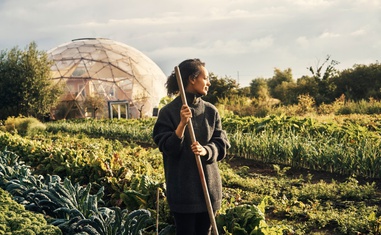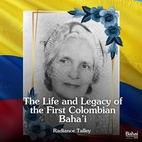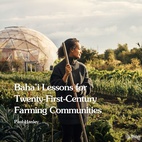The views expressed in our content reflect individual perspectives and do not represent the authoritative views of the Baha'i Faith.
The story of the Baha’i village of Adasíyyih, an early example of regenerative agriculture, offers valuable lessons for contemporary efforts to restore degraded landscapes and build vibrant communities.
Learnings from Adasíyyih will be particularly relevant for millions of villages around the world and the forty percent of humanity — more than 3 billion people, mostly smallholder farm families — directly engaged in growing the world’s food.
By now, we all know that addressing challenges at the village level is critical. Many of the issues facing humanity — inequality, conflict, extremism, fundamentalism, disease, supply chain breakdowns, climate change, erosion, water shortages, and biodiversity loss — impact rural people and landscapes directly. On the socioeconomic front, extreme poverty is largely found among rural populations. On the environmental front, rural people often face the most serious impacts of climate change and ecological degradation.
RELATED: Adasíyyih: A Baha’i Village Becomes a Model Farming Community
In 2018, in the document “Transforming Food and Agriculture to Achieve the SDGs: 20 interconnected actions to guide decision-makers,” the United Nations Food and Agriculture Organization (FAO) identified five principles, ten elements, and twenty evidence-based, result-oriented actions to support the positive transformation of food and agriculture systems and rural communities, with the goal of achieving the UN’s 2030 Sustainable Development Goals (SDGs). Remarkably, each one of these actions had been adopted in Adasíyyih one hundred years ago.
However, one additional area of action not considered in the FAO document — spirituality — proved essential to the community’s development in Adassiyih. Aside from reference to the importance of culture and values, a spiritual dimension is typically missing in most expositions of development processes. Yet the spiritual practices of the villagers of Adasíyyih were key to their success. Material and spiritual progress went hand in hand in the community.
Three protagonists — individuals, institutions, and the community as a whole — contributed to the development of the village of Adassiyih.
Individuals pursuing their own spiritual and moral development exhibited qualities such as honesty, trustworthiness, and a spirit of service. The Baha’i Local Spiritual Assembly — a focal point of unity — provided coordination and leadership in both a practical sense and by promoting moral education and harmonious family life. The Baha’i community — more than a collection of individuals — by dint of its devotional character, consultative processes, and institutions such as the Nineteen-Day Feast (a regular community meeting for devotions, consultation, and social connection) created a milieu in which its members could develop their love for one another and their capacities for service.
The creative Word of God, encountered in private prayer and study and in communal study and devotions, energized the community. Their covenant — essentially, their love for and loyalty to Abdu’l-Baha, the head of the global Baha’i community — forged an initial motivating factor in creating and shaping their efforts.
Abdu’l-Baha always recommended that the Baha’is in Adasíyyih should meet and hold frequent prayer sessions, after which they should, with the purest of motives, consult about their affairs. He advised them that they should treat their customers and neighbors, regardless of their background or religion, with a high degree of integrity and observe honor, courtesy, and fairness in their daily lives. In this atmosphere, spiritual and moral values permeated the mundane tasks of conducting a farming enterprise.
As the Universal House of Justice, the democratically-elected international governing council of the Baha’i Faith, observed, “… there is an inherent moral dimension to the generation, distribution, and utilization of wealth and resources.” That explains why Baha’is believe the role of spirituality in building unity and purpose in villages and neighborhoods should be considered a critical element in the transformative process.
During his fourth and last visit to Adasíyyih in 1920, a year before he passed away, Abdu’l-Baha was accompanied by his grandson Shoghi Effendi, future Guardian of the Baha’i Faith. During that visit, Abdu’l-Baha re-emphasized the importance of daily devotional gatherings and practicing consultation to resolve disputes. He advised the villagers to gather every night, pray, then consult to resolve personal problems. Four years later, in 1924, when the Local Spiritual Assembly was formed, it decided to implement these recommendations.
RELATED: How Spiritual Principles Can Revolutionize the Food Economy
On January 16, 1921, Abdu’l-Baha revealed a prayer (provisionally translated here by Adib Masumian) specifically for the farmers of Adasíyyih:
He is the All-Glorious
O Thou kind Lord, Thou Who art independent of all things! These servants of Thine traversed mountains and deserts, and crossed plains and seas, till they reached their desired destination, and now they have entered Ghawr [the Jordan Valley]. No haven or refuge do we have but Thee; none other do we wish to render us aid and answer our cries. Admit us into the shelter of Thy support, and protect us from faltering and wavering.
O divine Providence! The tests are intense, the trials without end. Unite us, make us one, that we may take one another in our embrace — that we may follow Thy Path, commune with Thee, and seek Thy good-pleasure.
For half a century, the Baha’is and their friends at Adasíyyih engaged in a concerted, pioneering effort to release the society-building powers of their Faith, to build a vibrant community, and to regenerate the land. Today, the results of their efforts provide an inspirational example for villages and neighborhoods everywhere.
This article is based on the book “’Adasíyyih: The Story of ’Abdu’l-Bahá’s Model Farming Community,” by Paul Hanley, Baha’i Publishing, 2024, 336 pages. The book is currently available exclusively from www.bahaibookstore.com/Adasiyyih-P10838.

















Comments
Sign in or create an account
Continue with Googleor